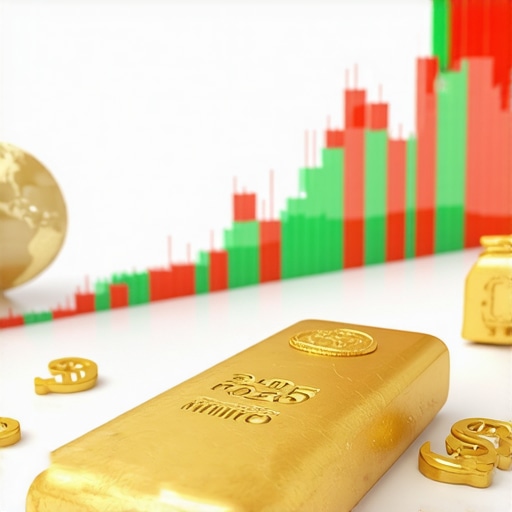Introduction to Gold Demand Trends in Today’s Market
Gold has long been regarded as a precious asset, serving not only as a form of currency but also as a hedge against inflation and economic uncertainty. Understanding gold demand trends is crucial for investors looking to make informed decisions about their portfolios. As we delve into the dynamics that influence gold demand, we will explore factors such as market sentiment, inflation rates, and the impact of geopolitical events.
Key Forces Driving Gold Demand Trends
The Role of Economic Uncertainty
Economic instability often leads to increased demand for gold, as investors seek safe-haven assets. During times of market turmoil, such as financial crises or global conflicts, gold tends to retain its value better than equities or other commodities. For instance, during the COVID-19 pandemic, many investors flocked to gold, driving prices to record highs. This phenomenon highlights the importance of understanding the role of economic uncertainty in shaping gold demand. For a deeper insight into how gold acts as a hedge during turbulent times, check out our article on The Role of Gold in Economic Uncertainty.
Inflation and Interest Rates
Inflation erodes purchasing power, prompting investors to turn to gold as a store of value. When inflation rates rise, central banks may respond by increasing interest rates, which can significantly affect gold prices. As interest rates rise, the opportunity cost of holding non-yielding assets like gold increases, potentially leading to lower demand. Analyzing these trends is vital for any investor looking to navigate the complexities of the gold market. To better understand how central bank actions influence gold demand, refer to our post on How Central Bank Actions Affect Gold Demand Trends.
Geopolitical Events and Their Impact
Geopolitical tensions can significantly affect gold demand. Events such as trade wars, sanctions, and military conflicts often lead to increased uncertainty in the global economy, prompting investors to seek the safety of gold. For example, during times of heightened geopolitical risk, the price of gold typically rises as demand surges. Staying informed about global events and their potential impact on gold demand is essential for savvy investors.
Emerging Market Demand
Emerging markets, particularly in Asia, are increasingly driving gold demand. Countries like China and India have a long-standing cultural affinity for gold, using it in jewelry, investments, and as a form of savings. As these economies grow, so does their demand for gold. Understanding emerging market trends can provide valuable insights into future gold demand. For more on investment strategies related to gold, consider our guide on Best Gold Investments for Beginners.
In conclusion, understanding the various forces driving gold demand trends is essential for anyone looking to invest in this precious metal. By keeping an eye on economic conditions, inflation rates, geopolitical events, and emerging market trends, investors can make more informed decisions about their gold investments.
Gold Demand Trends in Investment Strategies
Investors must adapt their strategies based on gold demand trends. Understanding these trends can guide investment decisions, whether in physical gold, ETFs, or gold mining stocks. For those new to investing, a great starting point is our Beginner’s Guide to Buying Gold, which outlines essential tips for entering the market.
Physical Gold vs. Gold ETFs
When considering gold investments, investors often face the choice between physical gold and gold ETFs. Physical gold, including bars and coins, provides a tangible asset that many find reassuring, especially during economic downturns. Conversely, gold ETFs offer liquidity and ease of trading, making them an attractive option for many investors. For a more detailed comparison, check out our article on Gold ETFs vs. Mutual Funds: Which Is Right for You?.
The Importance of Gold in Portfolio Diversification
Gold plays a crucial role in diversifying an investment portfolio. By including gold, investors can reduce overall risk, as gold often behaves differently than stocks and bonds. This diversification is particularly valuable during market volatility. To learn more about how to diversify with gold, explore our guide on Gold Stocks and Mutual Funds: Diversifying Your Portfolio.
Analyzing Gold Price Fluctuations
Factors Influencing Gold Prices
Understanding the factors that influence gold prices is essential for investors. Key elements include currency fluctuations, supply and demand dynamics, and geopolitical events. For instance, a weaker US dollar often leads to higher gold prices as it increases gold’s appeal to foreign investors. To grasp the nuances of these influences, refer to our post on Understanding Gold Prices: Key Influencers and Trends.
Gold Price Forecast: What to Expect
Forecasting gold prices can be a challenging task, yet it is vital for strategizing investments. Analysts often look at historical trends, current market conditions, and economic indicators to predict future movements. For insights into anticipated changes, read our analysis in Gold Price Forecast: Factors Influencing Future Values.
Long-term Outlook for Gold Investments
Gold as a Hedge Against Inflation
As inflation rates rise, gold is historically viewed as a hedge. Investors turn to gold during inflationary periods to preserve purchasing power. This trend reinforces the importance of keeping an eye on economic indicators, especially for long-term investors. To understand how gold can shield against inflation, check out our post on Gold and Inflation: Understanding Its Role as a Hedge.
Emerging Trends in Gold Investments
Staying updated with emerging trends in gold investments can be beneficial. As technology advances, new avenues such as gold-backed cryptocurrencies and online trading platforms are revolutionizing how investors approach gold. To navigate these changes, consider our essential guide on Navigating Gold Trading Platforms: Your Essential Guide.
In summary, understanding gold demand trends is crucial for informed investing. By analyzing economic indicators, price fluctuations, and emerging market dynamics, investors can better position themselves for success in the gold market. Whether you’re considering physical gold or gold ETFs, staying informed will enhance your investment strategy.
Gold Investment Strategies: Adapting to Market Trends
In a dynamic market, adapting your gold investment strategies is essential for success. Investors must remain vigilant regarding gold demand trends and market conditions. By doing so, they can adjust their portfolios accordingly, ensuring resilience against economic fluctuations. For practical insights into effective investment strategies, refer to our guide on Top Gold Investment Strategies to Maximize Your Returns.
Gold Stocks vs. Physical Gold: Making the Right Choice
When considering gold investments, many investors find themselves weighing the options between gold stocks and physical gold. Gold stocks can offer growth potential and dividends, while physical gold provides a tangible asset that can serve as a store of value. Understanding the pros and cons of each option is critical. Learn more about this comparison in our article on Comparing Gold Stocks vs. Physical Gold: What to Choose?.
Gold Mutual Funds: A Diversified Approach
Investing in gold mutual funds is another way to diversify your portfolio while gaining exposure to gold markets. These funds can provide a balanced approach, allowing investors to take advantage of the expertise of fund managers while benefiting from the performance of gold-related assets. For insights on selecting the best gold mutual funds, check out our post on Top Gold Mutual Funds to Consider for Investing in 2025.
Understanding the Role of Central Banks in Gold Demand
Central Banks as Major Gold Buyers
Central banks play a significant role in gold demand trends, often purchasing gold to diversify their reserves and hedge against inflation. Their buying patterns can significantly influence market dynamics. Understanding these trends can help investors anticipate price movements. For an in-depth look at central bank activities, read our analysis on Central Bank Gold Purchases: A Trend Analysis for 2025.
Influence of Geopolitical Events on Gold Prices
Geopolitical events often create uncertainty, prompting investors to flock to gold as a safe haven. Events such as trade disputes, military conflicts, and political instability can lead to spikes in gold prices. Staying informed about global events can enhance your investment decisions. To explore the impact of these factors on gold demand, refer to our post on How Central Bank Actions Affect Gold Demand Trends.
Future Outlook for Gold Investments
Gold Demand Trends in 2025 and Beyond
Predicting future gold demand trends requires a keen understanding of various economic indicators and market dynamics. Investors should monitor developments such as technological advancements, shifts in consumer behavior, and changes in government policies regarding gold ownership. For a comprehensive forecast, check out our article on Gold Price Forecast for 2025: Insights and Predictions.
Gold as a Portfolio Hedge: Strategies for Long-Term Investors
For long-term investors, incorporating gold into their portfolios can provide a hedge against inflation and market volatility. Understanding the role of gold in risk management is crucial for strategic investment planning. To learn more about utilizing gold as a hedge, visit our guide on Exploring the Role of Gold as a Portfolio Hedge.
In conclusion, navigating the complexities of gold investments necessitates a comprehensive understanding of market trends, central bank influences, and geopolitical factors. By staying informed and adapting investment strategies accordingly, investors can position themselves to capitalize on the opportunities presented by the gold market.
Maximizing Returns with Gold ETFs
Gold Exchange-Traded Funds (ETFs) have become increasingly popular among investors looking to gain exposure to gold without the complexities of owning physical gold. These investment vehicles allow you to invest in gold by tracking the price of gold bullion, making it an efficient way to invest in the gold market. To maximize your returns with gold ETFs, it’s important to understand their structure, benefits, and how to select the right ETFs for your portfolio.
Understanding Gold ETFs: What You Need to Know
Gold ETFs are funds that trade on stock exchanges, similar to stocks, and aim to mirror the performance of gold prices. They primarily invest in physical gold bullion, but some may also invest in gold mining companies. When considering gold ETFs, it’s crucial to evaluate their expense ratios and performance history. For more insights on choosing the right gold ETF for your portfolio, check out our guide on Understanding Gold ETFs: Key Considerations for Investors.
Benefits of Investing in Gold ETFs
Investing in gold ETFs offers several advantages. First, they provide liquidity, allowing investors to buy and sell shares quickly on the stock market. Second, they offer diversification, as your investment is spread across a pool of gold-related assets. Additionally, gold ETFs typically have lower fees compared to holding physical gold, making them an attractive option for both novice and seasoned investors. For a deeper understanding of the benefits of gold ETFs, explore our post on Gold ETFs vs. Mutual Funds: Which Is Right for You?.
Strategies for Investing in Gold ETFs
Timing Your Investment
Like any investment, timing plays a critical role in maximizing returns with gold ETFs. Investors should keep an eye on market trends and economic indicators that may influence gold prices. Key factors include inflation rates, interest rates, and geopolitical events. For further insights, refer to our analysis on Gold Price Fluctuations: Key Factors Influencing Trends.
Dollar-Cost Averaging
Dollar-cost averaging is a strategy that involves investing a fixed amount of money into gold ETFs at regular intervals. This approach can mitigate the impact of market volatility by allowing you to purchase more shares when prices are low and fewer when prices are high. Over time, this can lead to a lower average cost per share. To learn more about effective investment strategies, check out our article on Investing in Gold: How To Start for Beginners.
Rebalancing Your Portfolio
Regularly rebalancing your investment portfolio is essential to maintaining your desired asset allocation. If the value of your gold ETFs increases significantly, it may lead to an overexposure to gold compared to other asset classes. Consider setting a schedule to review and adjust your portfolio to ensure it aligns with your investment goals. For more on portfolio management, check out our post on Gold Investment Strategies: How to Stay Ahead in 2024.
Common Mistakes to Avoid with Gold ETFs
Neglecting Research
One of the most common mistakes investors make with gold ETFs is neglecting to conduct thorough research. Understanding the specific ETFs you are investing in, their expense ratios, and their performance history is crucial. Always stay informed about market trends and economic indicators that may affect gold prices. To enhance your knowledge, read our comprehensive guide on Gold Investment: A Comprehensive Guide to Buying Gold.
Overreacting to Short-Term Volatility
Gold prices can be volatile in the short term, influenced by various factors such as economic data releases and geopolitical tensions. It’s essential not to make impulsive decisions based on temporary market fluctuations. Maintaining a long-term perspective can help you stay focused on your investment goals. For more insights on navigating market volatility, refer to our article on How to Make Smart Decisions in Gold Investments.
Conclusion: A Strategic Approach to Gold ETF Investments
Investing in gold ETFs can be a strategic addition to your investment portfolio, offering a way to gain exposure to gold while minimizing costs and complexities. By understanding the fundamentals of gold ETFs, employing effective investment strategies, and avoiding common pitfalls, you can position yourself for success in the gold market. As you navigate the evolving landscape of gold investments, remember to stay informed about market trends and economic conditions. For additional insights into gold investments, explore our resource on Investing in Gold ETFs: A Smart Choice for Investors.
Frequently Asked Questions about Gold ETFs
What are Gold ETFs and how do they work?
Gold ETFs, or Gold Exchange-Traded Funds, are investment funds that trade on stock exchanges and aim to track the price of gold. They typically hold physical gold bullion or gold-related assets to provide investors with exposure to gold prices without the hassle of owning physical gold. Investors can buy and sell shares in these funds just like stocks, making them a liquid and flexible investment option.
Are Gold ETFs a safe investment?
While Gold ETFs can be a safer alternative to owning physical gold, they still carry risks. The value of Gold ETFs fluctuates based on gold prices, which can be affected by economic conditions, interest rates, and geopolitical events. Investors should assess their risk tolerance and consider diversifying their portfolios to mitigate potential risks associated with investing in Gold ETFs.
What is the difference between Gold ETFs and mutual funds?
Gold ETFs and mutual funds both provide exposure to gold, but they differ in structure and trading. Gold ETFs are traded on stock exchanges like individual stocks, allowing for real-time buying and selling. In contrast, mutual funds are typically bought and sold at the end of the trading day at the net asset value (NAV) price. Additionally, Gold ETFs usually have lower expense ratios compared to mutual funds.
Can I hold Gold ETFs in my retirement account?
Yes, you can hold Gold ETFs in tax-advantaged retirement accounts like IRAs and 401(k)s. This can be an effective way to gain exposure to gold while benefiting from tax advantages. However, be sure to check the specific rules and regulations of your retirement account and consult with a financial advisor to ensure compliance.
What factors influence the price of Gold ETFs?
The price of Gold ETFs is influenced by several factors, including global gold prices, supply and demand dynamics, economic indicators, and geopolitical tensions. Additionally, currency fluctuations, particularly the strength of the U.S. dollar, can impact gold prices and, consequently, the performance of Gold ETFs.
How do I choose the best Gold ETF for my portfolio?
When selecting a Gold ETF, consider factors such as the fund’s expense ratio, performance history, liquidity, and the amount of physical gold held by the fund. Researching the ETF’s management team and their investment strategy can also provide valuable insights. Consulting resources like Morningstar or ETF.com can help you make informed decisions.
What are the tax implications of investing in Gold ETFs?
Investing in Gold ETFs can have tax implications, as gains from selling ETF shares may be subject to capital gains tax. The tax treatment can vary based on how long the investment is held and your individual tax situation. It’s advisable to consult with a tax professional to understand how investing in Gold ETFs will impact your taxes.
Is it better to invest in physical gold or Gold ETFs?
Whether to invest in physical gold or Gold ETFs depends on your investment goals and preferences. Physical gold offers tangible asset ownership but comes with storage and insurance costs. Gold ETFs provide a more liquid and convenient investment option with lower fees, making them appealing for those looking to gain exposure to gold without the complexities of holding physical bullion.
How can I stay updated on Gold ETF performance?
To stay updated on Gold ETF performance, consider following financial news websites, subscribing to investment newsletters, and utilizing investment apps that track ETF performance. Additionally, resources like Bloomberg and Reuters provide timely updates and analysis on gold market trends and ETF performance.
Conclusion: Gold ETFs as a Strategic Investment Choice
Gold ETFs offer a compelling opportunity for investors looking to diversify their portfolios and hedge against economic uncertainty. By understanding their structure, benefits, and strategies for investment, you can make informed decisions that align with your financial goals. Whether you are a seasoned investor or just starting, considering Gold ETFs can enhance your investment strategy and provide valuable exposure to the gold market.










